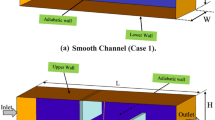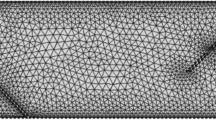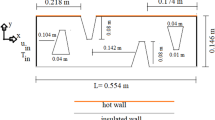Abstract
Numerical studies of momentum and heat transfer characteristics have been investigated of a steady incompressible turbulent flow of air through channel. The channel has inclined baffles which are arranged on the walls in a periodically staggered way. The governing equations, namely, continuity, Navier–Stokes and energy, based on k–ω turbulence model to describe the turbulence phenomenon are solved using the finite volume method and the SIMPLE algorithm. Calculations are performed for a Reynolds number between 12,000 and 38,000. The axial velocity profiles, the velocity fields, the local and average coefficient of friction and the Nusselt number distribution were obtained for all the geometry considered and for different sections selected, upstream, downstream and between the two inclined baffles. Simulation results which were obtained by the use of baffles are validated by an experimental study. Good agreement is observed between numerical and experimental results data in the literature.














Similar content being viewed by others
Abbreviations
- a:
-
Sound speed
- Cp :
-
Specific heat at constant pressure (J/kg K)
- D:
-
Distance between two baffles (m)
- Dh :
-
Hydraulic diameter of channel, (Dh = 2H) (m)
- Dω :
-
Crossing the diffusion term (m2/s)
- e:
-
Width of plate baffle (m)
- f :
-
Friction factor
- f 0 :
-
Friction factor in smooth pipe at the same Reynolds number
- F(M t ):
-
The compressibility function
- Gk :
-
Production of turbulent kinetic energy due to velocity gradient through (m2/s2)
- Gω :
-
Kinetic energy production due to buoyancy (m2/s2)
- h:
-
Baffle height (m)
- H:
-
Height of air tunnel in pipe (m)
- k:
-
Turbulent kinetic energy (m2/s2)
- L:
-
Channel length (m)
- L1 :
-
Distance upstream of the first baffle (m)
- L2 :
-
Distance downstream of the second baffle (m)
- \( \overline{Nu} \) :
-
Averaged Nusselt number
- \( Nu_{x} \) :
-
Local Nusselt number
- P:
-
Pressure (pa)
- Pr:
-
Prandtl number
- Prt :
-
Turbulent Prandtl number
- Re:
-
Reynolds number
- \( \text{Re}_{t} \) :
-
One of the constants of the k–ω turbulence model
- R k :
-
One of the constants of the k–ω turbulence model
- \( \text{Re}_{\omega } \) :
-
One of the constants of the k–ω turbulence model
- Sk, Sω :
-
Source term for k and ω
- T:
-
Temperature (°C)
- ui :
-
Velocity components in the xi-direction (m/s)
- uj :
-
Components in the xj-direction (m/s)
- Uin :
-
Inlet velocity (m/s)
- \( \overline{U} \) :
-
Mean velocity in channel (m/s)
- u, v:
-
Fluid velocity in the x, y direction (m/s)
- \( \overrightarrow {V} \) :
-
Velocity vector (m/s)
- x:
-
Longitudinal nodal increments (m)
- xi, xj :
-
Cartesian coordinates (m)
- Yk, Yx :
-
Dissipation of k and ω (m2/s)
- ω:
-
The specific dissipation rate of turbulence energy (m2/s)
- \( \Upgamma_{k} \), \( \Upgamma_{\omega } \) :
-
Effective diffusivity of k and ω
- ρ:
-
Linear density of the air (kg/m)
- λ :
-
Thermal conductivity (w/m °C)
- μ:
-
Dynamic viscosity (kg/ms)
- μ l , μ t :
-
Laminar, turbulent viscosity (kg/ms)
- μf :
-
Dynamic viscosity of fluid (kg/ms)
- μ e :
-
Effective viscosity (Pa s)
- ν :
-
Kinematics viscosity (m2/s)
- σk :
-
Model constant for the k-equation
- σω :
-
Model constant for the ω-equation
- τ w :
-
The shear stress to the wall (kg/(s2 m))
- Δp :
-
Pressure losses
- α :
-
Coefficient of thermal expansion (K−1)
- δ ij :
-
Stress tensor
- \( \alpha^{ * } \) :
-
Coefficient of the turbulent viscosity causing a low-Reynolds-number correction
- \( \alpha_{\infty }^{ * } \) :
-
One of the constants of k–ω turbulence model
- \( \alpha_{0}^{ * } \) :
-
One of the constants of k–ω turbulence model
- f β :
-
One of the constants of k–ω turbulence model
- χ ω :
-
One of the constants of k–ω turbulence model
- \( \zeta^{*} \) :
-
One of the constants of the model k−ω
- \( M_{t}^{2} \) :
-
One of the constants of k–ω turbulence model
- \( M_{t0} \) :
-
One of the constants of k–ω turbulence model
- ϕ :
-
Represents the dependent variables of u, v, p, k, ω, and T
- \( \phi^{ * } \) :
-
Denote values of the previews iterations
- δ :
-
Prescribed error
- in, out :
-
Inlet, outlet of the test section
- b:
-
Bulk
- t :
-
Turbulent
- w :
-
Wall
- e :
-
Effective
- f :
-
Fluid
- s :
-
Solid
- i, j :
-
Refers coordinate direction vectors
References
Yang YT, Hwang CZ (2003) Calculation of turbulent flow and heat transfer in a porous-baffled channel. Int J Heat Mass Transf 46:771–780
Dutta P, Hossain A (2005) Internal cooling augmentation in rectangular channel using two inclined baffles. Int J Heat Fluid Flow 26:223–232
Saffar-Avval M, Damangir E (1995) A general correlation for determining optimum baffle spacing for all types of shell and tube exchangers. Int J Heat Mass Transf 38:2501–2506
Founti MA, Whitelaw JH (1981) Shell side flow in a model disc and doughnut heat exchanger, Tech. Report FS/81/37. Mech. Eng. Dept., Imperial College, London, UK
Berner C, Durst F, McEligot DM (1984) Flow around baffles. Trans ASME J Heat Transf 106:743–749
Berner C, Durst F, McEligot DM (1984) Streamwise-periodic flow around baffles. In: Proceedings of the 2nd international conference on applications of laser anemometry to fluid mechanics, Lisbon, Portugal
Habib MA, Mobarak AM, Sallak MA, Abdel Hadi EA, Affify RI (1994) Experimental investigation of heat transfer and flow over baffles of different heights. Trans ASME J Heat Transf 116:363–368
Dutta P (1997) Cooling opportunity in advanced turbine system (ats) row one vane, a report on industrial projects submitted to the advanced gas turbine systems research, Clemson, SC
Dutta P (1997) Innovative heat transfer enhancement with inclined solid and perforated baffles, MS Thesis, University of South Carolina, Columbia, SC
Dutta P, Dutta S (1998) Effect of baffle size, perforation, and orientation on internal heat transfer enhancement. Int J Heat Mass Transf 41:3005–3013
Dutta S, Dutta P, Jones RE, Khan JA (1998) Heat transfer coefficient enhancement with perforated baffles. ASME J Heat Transf 120:795–797
Webb BW, Ramadhyani S (1985) Conjugate heat transfer in a channel with staggered ribs. Int J Heat Mass Transf 28:1679–1687
Kelkar KM, Patankar SV (1987) Numerical prediction of flow and heat transfer in parallel plate channel with staggered fins. Trans ASME J Heat Transf 109:25–30
Habib MA, Attya AE, McEligot DM (1988) Calculation of turbulent flow and heat transfer in channels with streamwise-periodic flow. Trans ASME J Turbomach 110:405–411
Amano RS, Bagherle A, Smith RJ, Niess TG (1987) Turbulent heat transfer in corrugated wall channels with and without fins. Trans ASME J Heat Transf 109:62–67
Lopez JR, Anand NK, Fletcher LS (1996) Heat transfer in a three-dimensional channel with baffles. Numer Heat Transf Part A 30:189–205
Hwang JJ, Liou TM (1995) Heat transfer and friction in a low-aspect ratio rectangular channel with staggered perforated ribs on two opposite walls. ASME J Heat Transf 117:843–850
Nasiruddin MH, Kamran S (2007) Heat transfer augmentation in a heat exchanger tube using a baffle. Int J Heat Fluid Flow 28:318–328
Oztop HF, Dagtekin I (2003) Enhancement of heat transfer in a pipe with inner contraction-expansion-contraction pipe insertion. Int Commun Heat Mass Transf 30:1157–1168
Endres LAM, Moller SV (2001) On the fluctuating wall pressure field in tube banks. Nucl Eng Des 203:13–26
Gupta BB, Howell JA, Wu D, Field RW (1995) A helical baffle for cross-flow micro filtration. J Membr Sci 99:31–42
Kang HK, Anand NK (2003) Use of porous baffles to enhance heat transfer in a rectangular channel. Int J Heat Mass Transf 46:4191–4199
Molki M, Mostoufizadeh AR (1989) Turbulent heat transfer in rectangular ducts with repeated-baffle blockages. Int J Heat Mass Transf 32:1491–1499
Lei YG, He Y, Chu P, Li R (2008) Design and optimization of heat exchangers with helical baffles. Chem Eng Sci 63:4386–4395
Wilfried R, Deiying WL (1994) Effect of baffle/shell leakage flow on heat transfer in shell-and-tube heat exchanger. Exp Therm Fluid Sci 8:10–20
Turan B (2010) Investigation of mixed convection heat transfer in pipes with sharp-edged disc inserted. MsC thesis, Fırat University
Somchai S, Pongjet P (2009) Numerical analysis of laminar heat transfer in a channel with diamond-shaped baffles. Int Comm Heat Mass Transf 36:32–38
Benzenine H, Saim R, Benyoucef B, Abboudi S, Imine O (2010) Numerical analysis of turbulent flow and conjugate heat transfer characteristics in channel provided with internal waved fins and baffles: effect of pitch of waved fins and baffles. In: Proceedings of ASME 2010 3rd Joint US-European fluids engineering summer meeting and 8th International Conference Nanochannels, Microchannels, Minichannels FEDSM2010-ICNMM2010, Montreal, Canada
Seong-Mok M (2006) Turbulent Flow Modeling, Consulting Team/ CFD Div. 1
Patankar SV (1980) Numerical heat transfer and fluid flow. Hemisphere, New York
Demartini LC, Vielmo HA, Möller SV (2004) Numeric and experimental analysis of the turbulent flow through a channel with baffle plates. J Braz Soc Mech Sci Eng 26:153–159
FLUENT 6.3 User’s Guide, September 2006
Author information
Authors and Affiliations
Corresponding author
Rights and permissions
About this article
Cite this article
Saim, R., Bouchenafa, R., Benzenine, H. et al. A computational work on turbulent flow and heat transfer in a channel fitted with inclined baffles. Heat Mass Transfer 49, 761–774 (2013). https://doi.org/10.1007/s00231-013-1121-3
Received:
Accepted:
Published:
Issue Date:
DOI: https://doi.org/10.1007/s00231-013-1121-3




